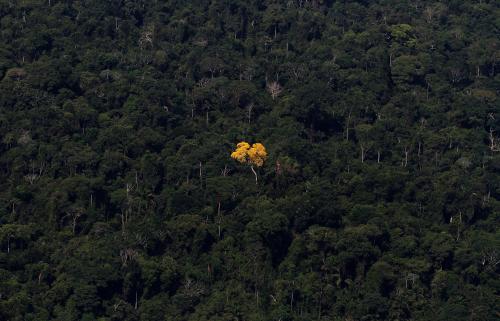The recently published Sixth Assessment Report of the Intergovernmental Panel on Climate Change (IPCC-AR6) cautioned that climate change is already affecting every inhabited region of the globe, and the scale of recent changes is unprecedented on a millennial time scale. The discussions at COP26 highlighted the critical need for countries to accelerate reduction of greenhouse gas (GHG) emissions and move toward net zero in the longer term. This will require large-scale climate finance, with private capital mobilization in the trillions of dollars through sustainability-linked bonds and impact investment, as countries make the transition to low carbon economies. These initiatives will need new performance metrics that measure GHG emissions reductions.
Limited information has hindered decisionmaking
Performance measurement in this domain has been hobbled by the near-total absence of directly measured local and regional GHG data for problem diagnosis and program assessment. Consistently measured GHG estimates are scanty, and most rely on emissions parameters from engineering studies that are applied to survey-based activity measures for transport, energy production, and manufacturing. The parameters are particularly suspect for developing countries because many have been calibrated using databases and models in high-income economies.
Satellite-based data hold the key to global performance tracking
Sentinel satellites can be powerful allies, with high-resolution GHG measures now available from many platforms, including NASA’s OCO-2 and OCO-3 instruments, the European Space Agency’s METOP-A and TROPOMI (Sentinel-5P) platforms, China’s TANSAT, and the Japan Space Exploration Agency’s GOSAT and GOSAT-2.
In a recent working paper, we used new satellite data to measure and analyze CO2 emissions from over 1,000 global cities. We chose to use NASA’s OCO (Orbiting Carbon Observatory)-2, which offers open access, a long panel of consistently measured daily observations, and the highest spatial resolution among the available sources. We focused on cities with more than 500,000 people, as these localities have high concentrations of economic activity and emissions.
Our econometric model of the CO2 emitted by cities takes account of their most carbon-intensive industrial activities (power plants, steel mills, refineries, cement plants); local fires (carbon emissions from agricultural and forest burning); incomes; populations; population densities; and climate-based heating needs. After the model accounts for these factors, the regression residuals provide performance indicators that identify cities whose CO2 emissions are less than or greater than model-based expectations. This provides the first empirical scorecard of urban CO2 emissions management that is based on actual CO2 observations.
How do global cities perform?
Figure 1. Residuals from regression-predicted CO2 concentrations (ppm) for cities with populations of more than 500,000
 Source: Urban CO2 Emissions: A Global Analysis with New Satellite Data.
Source: Urban CO2 Emissions: A Global Analysis with New Satellite Data.
Figure 1 shows that the performance measured by city regression residuals exhibits wide variation, both within and across regions. However, Figure 2 shows that regional patterns do differ significantly. China has a striking number of large positive residuals (indicating CO2 emissions greater than expectations), while the former Comecon countries have many large negative residuals.
Figure 2. City CO2 performance by region
 Note: CHN China; AFR sub-Saharan Africa; EAP East Asia & Pacific (excluding China); MENA Middle East & North Africa; LAC Latin America & Caribbean; SAS South Asia (excluding India); NAM North America; IND India; WEU Western Europe; CEC Former Comecon countries (Soviet Union, Eastern Europe).
Note: CHN China; AFR sub-Saharan Africa; EAP East Asia & Pacific (excluding China); MENA Middle East & North Africa; LAC Latin America & Caribbean; SAS South Asia (excluding India); NAM North America; IND India; WEU Western Europe; CEC Former Comecon countries (Soviet Union, Eastern Europe).
Source: Urban CO2 Emissions: A Global Analysis with New Satellite Data.
Other regions with larger-than-expected residuals include East Asia & the Pacific, sub-Saharan Africa, and the Middle East & North Africa. Western Europe and India have smaller-than-expected residuals, while distributions are roughly centered around the global average for North America, Latin America & the Caribbean, and South Asia (excluding India).
Satellite sentinels are opening a new frontier for GHG performance analysis
We are optimistic that the World Bank and other institutions will expand this new approach to performance measurement using satellite-based CO2 monitoring. While our study has focused on large cities, the same model could be used in geographic settings as varied as large and small cities within regions or countries, regions within countries, or specific project areas. To provide better metrics to track progress in greenhouse gas reduction, we hope to extend this pilot initiative to an open-source, regularly updated CO2 database that will inform all global stakeholders.
-
Acknowledgements and disclosures
Photo credit: NASA/JPL-Caltech






Commentary
Deploying ‘sentinel satellites’ to monitor greenhouse gas emissions
November 17, 2021